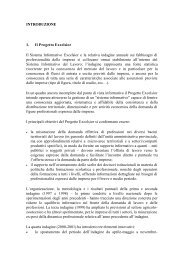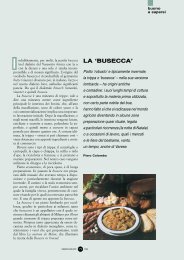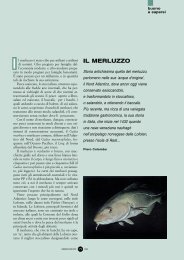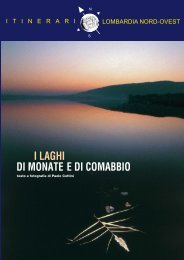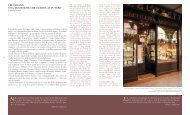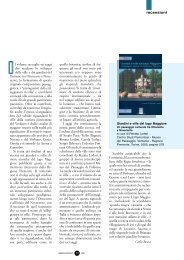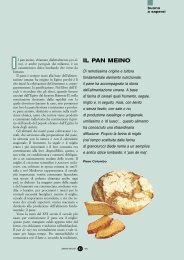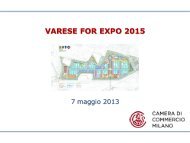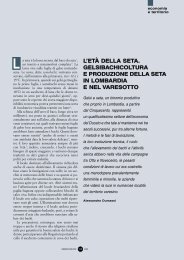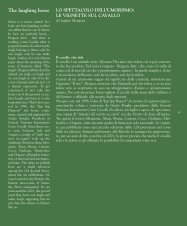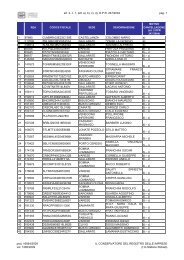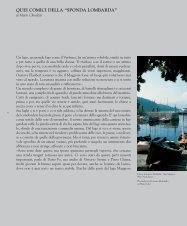IL TESSILE “VERDE” SFIDA LA CRISI - CCIAA di Varese
IL TESSILE “VERDE” SFIDA LA CRISI - CCIAA di Varese
IL TESSILE “VERDE” SFIDA LA CRISI - CCIAA di Varese
Create successful ePaper yourself
Turn your PDF publications into a flip-book with our unique Google optimized e-Paper software.
Dal quadro dell’artista varesino Alberto<br />
Magnani – Orange Jacket – la sintesi tra<br />
stile e impren<strong>di</strong>toria, tra rigore e fantasia,<br />
che sorreggono le ricerche ver<strong>di</strong> del tessile<br />
varesino<br />
“Orange Racket”, the painting of the artist<br />
Alberto Magnani, who comes from <strong>Varese</strong>,<br />
is a synthesis of style and entrepreneurship,<br />
of imagination and severity, that is of elements<br />
which sustain eco-friendly researches<br />
in our textile field<br />
<strong>IL</strong> TESS<strong>IL</strong>E <strong>“VERDE”</strong><br />
<strong>SFIDA</strong> <strong>LA</strong> <strong>CRISI</strong><br />
Andrea Aliverti
58<br />
F<br />
ibre naturali, sensori, biotecnologie. Sono gli assi <strong>di</strong> sviluppo del sempre più battuto<br />
filone del tessile ecologico, la speranza per ridare competitività ad una filiera<br />
sfiancata dalla crisi ma ancora piena <strong>di</strong> risorse e <strong>di</strong> energie positive per guardare<br />
avanti e riaffermarsi all’insegna dell’innovazione.<br />
Adesso la Fibra è <strong>di</strong> Bambù<br />
Punto <strong>di</strong> riferimento in questo campo è il Centro Tessile Cotoniero <strong>di</strong> Busto Arsizio<br />
<strong>di</strong>retto da Grazia Cerini, che supporta e coor<strong>di</strong>na il lavoro delle aziende nell’accesso<br />
ai ban<strong>di</strong> specifici e che attraverso le prove <strong>di</strong> laboratorio certifica e caratterizza i prodotti<br />
innovativi.<br />
A tracciare la strada nel 2006 era stato il progetto ‘Meta’ (miglioramento ecologico<br />
tessile abbigliamento) finanziato dalla Camera <strong>di</strong> Commercio, che ha ottenuto il<br />
risultato <strong>di</strong> trovare prodotti chimici a maggior tasso <strong>di</strong> biodegradabilità garantendo<br />
l’alta qualità produttiva. Una delle gran<strong>di</strong> speranze è la fibra <strong>di</strong> bambù, lanciata con<br />
il progetto ‘Competere’ anch’esso promosso dall’ente camerale e testata dal<br />
Centrocot: naturale, traspirante e biodegradabile, era stata già presentata con una<br />
linea ad hoc utilizzata dalla nazionale italiana <strong>di</strong> pitch and putt.<br />
Le sperimentazioni proseguono (oggi si parla in realtà <strong>di</strong> viscosa <strong>di</strong> bambù) e confluiranno<br />
all’interno <strong>di</strong> un nuovo ambizioso progetto che vede il Comune <strong>di</strong> Busto<br />
Arsizio capofila insieme al Centro Tessile Cotoniero: la costituzione <strong>di</strong> un polo texsport<br />
che punta a concentrare sul nostro territorio le energie per lo sviluppo dell’innovazione<br />
nel campo del tessile sportivo. Lavorando su tre linee in particolare: le<br />
fibre naturali, le fibre sintetiche per gli utilizzi tecnici e i cosiddetti smart textiles, tessuti<br />
intelligenti attraverso l’applicazione <strong>di</strong> sensori all’interno del tessuto.<br />
I Tessuti si Fanno Intelligenti<br />
In quest’ultima <strong>di</strong>rezione procede anche il progetto ‘Sensor Wear’, promosso da<br />
Regione e Centrocot. Uno dei primi risultati applicativi è la realizzazione <strong>di</strong> un prototipo<br />
<strong>di</strong> maglia sensorizzata in grado <strong>di</strong> rilevare il battito car<strong>di</strong>aco, che ora è pron-<br />
The “Green” textile industry<br />
faces the Crisis<br />
Natural fibres, sensors and<br />
biotechnologies: These are the<br />
strong points of the textile sector,<br />
whose ecological qualities are<br />
more and more demanded. We<br />
hope that these factors will give<br />
again competitiveness to this<br />
field, weakened by the crisis, but<br />
still full of resources and positive<br />
energies to look ahead and to<br />
reaffirm itself in the name of<br />
innovation.<br />
Now there is bamboo fibre<br />
The Centro Tessile Cotoniero of<br />
Busto Arsizio is the point of reference<br />
of this sector. The firm is<br />
run by Grazia Cerini, who supports<br />
and coor<strong>di</strong>nates enterprises<br />
in tendering for particular competitions.<br />
She also certifies and<br />
defines innovative products<br />
though specific laboratory tests.<br />
This idea was inaugurated in<br />
2006 with a project called META<br />
(Textile ecological improvement<br />
of clothing industry), which<br />
allowed to find high biodegradable<br />
chemical products and to<br />
guarantee at the same time a very<br />
high productive quality. Textile<br />
sector pins its hopes on bamboo<br />
fibre, launched thanks to the<br />
project Competere and tested by<br />
Centrocot. This fibre, which was<br />
already introduced with a specific<br />
line used by the Italian pitch and<br />
putt team, is natural, breathable<br />
and biodegradable. The actual<br />
tests, which regard precisely bamboo<br />
viscose, will converge in a<br />
new ambitious mission promoted<br />
by the Comune of Busto Arsizio<br />
and the Centro Tessile<br />
Cotoniero: The creation of a<br />
“tex-sport” centre aimed at concentrating<br />
all the energies of our<br />
land on innovation of sports textile<br />
sector. This project regards in<br />
particular three lines: Natural<br />
fibres, synthetic fibres for technical<br />
use and the so-called “smart<br />
textiles”, that is textiles equipped<br />
with internal sensors.<br />
Textiles become smart<br />
The project Sensor Wear, supported<br />
by our Region and<br />
Centrocot, is based on the production<br />
of Smart Textiles.<br />
Among its first concrete goals<br />
there is the prototype of a shirt<br />
provided with sensors for heartbeat’s<br />
measurement. This shirt is<br />
ready for industrial production.<br />
Among natural fibres it is particularly<br />
used biological and organic<br />
cotton, which is produced for<br />
child’s clothes. Even yarns made<br />
of precious materials like silver<br />
are tested. Tessitura Caielli of<br />
Vergiate has been promoting this<br />
initiative, connected with the<br />
project Matin: “We produce handkerchiefs”,<br />
explains the owner of<br />
the firm, Clau<strong>di</strong>o Caielli, “and we<br />
propose to use a 10% of silver yarn<br />
in order to exploit its antibacterial<br />
power. This silver yarn could partly<br />
solve the problem of the handkerchiefs<br />
accused of sprea<strong>di</strong>ng bacteria<br />
after several uses. Besides, this percentage<br />
of silver does not affect the<br />
softness of the product”.<br />
Biotex in order to reduce environmental<br />
impact<br />
An other booming sector is the<br />
Il filo <strong>di</strong> bambù e il filo d’argento tessono la trama dei nuovi tessuti “ecologici” e innovativi<br />
(fotografie Paolo Zanzi e Flavio Zulle)<br />
Bamboo and Silver thread weave the new eco-friendly and innovative textiles<br />
(photographs by Paolo Zanzi and Flavio Zulle)<br />
59
60<br />
(fotografie Flavio Zulle e Paolo Zanzi)<br />
61
62<br />
ta per la fase <strong>di</strong> preindustrializzazione.<br />
Tra le fibre naturali si sta <strong>di</strong>ffondendo l’uso del cotone biologico od organico de<strong>di</strong>cato<br />
in particolare all’abbigliamento per bambini ma si sperimentano persino i filati in<br />
materiale prezioso, come l’argento. E’ un’iniziativa che sta conducendo la Tessitura<br />
Caielli <strong>di</strong> Vergiate, nell’ambito del progetto ‘Matin’ <strong>di</strong> Regione e Unioncamere con<br />
la collaborazione del Centrocot: “Produciamo fazzoletti da naso – spiega il titolare dell’azienda<br />
artigiana, Clau<strong>di</strong>o Caielli – e inten<strong>di</strong>amo inserire il filato <strong>di</strong> argento fino al 10%<br />
per sfruttare il suo potere antibatterico, che risolverebbe in parte il problema dei fazzoletti<br />
accusati <strong>di</strong> <strong>di</strong>ffondere i batteri dopo un certo numero <strong>di</strong> utilizzi. Tra l’altro la presenza dell’argento<br />
pare non influisca sulla morbidezza del prodotto”.<br />
Biotex per Ridurre l’Impatto Ambientale<br />
Un altro asse in espansione è quello delle biotecnologie: enzimi e biomasse fungine per sostituire<br />
sostanze ad alto impatto ambientale come la soda caustica nei processi <strong>di</strong> preparazione e<br />
nobilitazione tessile, ma anche tinture con coloranti naturali e finissaggi dermo-compatibili<br />
ipoallergenici.<br />
Il fronte più avanzato è il progetto ‘Biotex’, nel quale è coinvolto il Centrocot per la parte <strong>di</strong><br />
ricerca e sviluppo oltre ad alcune aziende varesine (Mascioni <strong>di</strong> Cuvio, Tessitura Enrico Sironi<br />
<strong>di</strong> Gallarate, C. Sandroni <strong>di</strong> Busto Arsizio). L’obiettivo è verificare la fattibilità <strong>di</strong> processi sperimentali<br />
che attraverso l’uso delle biotecnologie possano essere in grado <strong>di</strong> migliorare da una<br />
Orsa Faom: Il Tessuto Non Tessuto<br />
C’è lo zampino del tessile ecologico dell’Orsa Foam nell’accappatoio del G8.<br />
Nelle camere della caserma della Guar<strong>di</strong>a <strong>di</strong> Finanza dell’Aquila i gran<strong>di</strong> della<br />
Terra hanno trovato un comodo accappatoio in microfibra realizzato con la tecnologia<br />
d’avanguar<strong>di</strong>a <strong>di</strong> “tessuto non tessuto” elaborata negli stabilimenti<br />
dell’Orsa Foam <strong>di</strong> Gorla Minore. “La presenza al G8 è merito del nostro cliente<br />
che commercializza queste applicazioni – racconta Alberto Schiavi, presidente<br />
dell’azienda chimica varesina – noi facciamo il tessuto, una tecnologia<br />
che ha prospettive <strong>di</strong> applicazione incommensurabili rispetto ad un semplice<br />
accappatoio”. Si chiama Lana NTT l’invenzione entrata a far parte del novero<br />
dei 237 progetti innovativi del made in Italy. Un nuovo tipo <strong>di</strong> tessuto rea-<br />
biotechnological one: it includes<br />
enzymes and fungus biomasses<br />
used during the process of textile<br />
production and textile improvement<br />
and aimed at replacing<br />
materials with a high environmental<br />
impact like caustic soda;<br />
it also includes natural dyes and<br />
hypo-allergenic dermato-compatible<br />
finishing.<br />
Biotex represents the most innovative<br />
project. It involves<br />
Centrocot for researches and<br />
development aspects and some<br />
firms of <strong>Varese</strong> (Mascioni of<br />
Cuvio, Tessitura Enrico Sironi of<br />
Gallarate, C. Sandroni of Busto<br />
Arsizio). The aim of the project is<br />
to study the feasibility of the<br />
experimental processes which use<br />
biotechnologies in order to<br />
improve features and effectiveness<br />
of the products and to<br />
reduce the environmental impact<br />
during the production cycle.<br />
There are three lines of action:<br />
bio catalytic processes for the<br />
enzymatic treatment of textile<br />
substratum in place of chemical<br />
products; bioactive textiles (use<br />
of enzymes which give textiles<br />
specific features); bio-absorption<br />
for the treatment of dyeing<br />
wastewater using fungus biomasses.<br />
Piero Sandroni, textile entrepreneur<br />
and advisor of Centrocot<br />
affirms: “This trend toward an ecological<br />
textile industry is noticeable.<br />
We also register a rising interest in<br />
the use of natural fibres and textiles,<br />
but also in the use of fibres that are<br />
treated, improved and coloured with<br />
substances boasting a very low or<br />
inexistent environmental impact”.<br />
We can save energy<br />
Energy conservation represents<br />
one of the most appreciated solutions<br />
chosen by consumers. Also<br />
competitors coming from the Far<br />
East have been noticing it. So, in<br />
2008, 48,8% of the 90.000 Oekotex<br />
certificates issued regarded<br />
requests from Asia. In other<br />
words it is necessary not to miss<br />
the train on which the future of<br />
our textile industry travels.<br />
However the concept of environmental<br />
sustainability includes<br />
energy conservation during the<br />
productive process. An innovative<br />
example of long stan<strong>di</strong>ng<br />
and efficient energy conservation<br />
is offered by Tintoria “G. Tosi”,<br />
Viale delle Industrie, Busto<br />
Arsizio. Luciano Orsenigo, its<br />
vice-president, explains: “For<br />
more than twenty years, we have<br />
been adopting a system of energy cogeneration<br />
and a reduction of power<br />
consumption through the reutilization<br />
of the warm water <strong>di</strong>scharged”.<br />
parte la funzionalità e le caratteristiche dei prodotti e dall’altra <strong>di</strong> ridurre l’impatto ambientale<br />
delle lavorazioni.<br />
Le linee d’azione sono tre: processi biocatalici per il trattamento enzimatico <strong>di</strong> substrati tessili<br />
in sostituzione dei prodotti chimici, tessili bioattivi (utilizzo <strong>di</strong> enzimi per conferire proprietà<br />
specifiche ai tessuti) e bioassorbimento per il trattamento dei reflui <strong>di</strong> tintura con biomasse<br />
fungine. “La spinta verso il tessile ecologico è percepibile – sostiene Piero Sandroni, impren<strong>di</strong>tore<br />
tessile e consigliere del Centrocot – cresce l’interesse verso l’utilizzo non solo <strong>di</strong> tessuti e fibre naturali<br />
ma anche trattate, nobilitate e colorate con sostanze a bassissimo o nullo impatto ambientale”.<br />
Risparmiare l’Energia si Può<br />
Una strada che ottiene sempre maggiori consensi anche tra i consumatori: se ne stanno<br />
accorgendo anche i competitor dell’Estremo Oriente, tanto che nel 2008 il 48.8%<br />
dei 90mila certificati Oeko-tex rilasciati sono stati assegnati a richieste provenienti<br />
dall’Asia. Come <strong>di</strong>re, bisogna affrettarsi per non perdere il treno su cui transita il<br />
futuro della nostra industria tessile. La strada verso l’ecosostenibilità del settore passa<br />
però anche per il risparmio energetico nei processi produttivi: in questo senso un<br />
esempio <strong>di</strong> efficienza e <strong>di</strong> innovazione <strong>di</strong> lunga data è la Tintoria “G. Tosi” <strong>di</strong> viale<br />
delle Industrie a Busto Arsizio. “Da più <strong>di</strong> vent’anni – spiega il vicepresidente Luciano<br />
Orsenigo – abbiamo introdotto un sistema <strong>di</strong> cogenerazione dell’energia elettrica e una riduzione<br />
dei consumi energetici attraverso il recupero degli scarichi <strong>di</strong> acqua calda”.<br />
lizzato senza filo e telaio, che sfrutta una materia prima naturale con una<br />
nuova tecnologia ed è capace <strong>di</strong> valorizzare le caratteristiche «uniche» della<br />
lana, idrorepellenza, permeabilità al vapore acqueo, termoisolamento, fonoassorbenza,<br />
resistenza al fuoco. Le possibili applicazioni toccano <strong>di</strong>versi settori<br />
oltre all’abbigliamento, tra cui arredamento, e<strong>di</strong>lizia, insonorizzazioni. Nel tessile<br />
“…la prima applicazione, e la più valida – spiega Schiavi –, riguarda le<br />
imbottiture per mantenere la temperatura. Teniamo conto che a parità <strong>di</strong> potere<br />
termico un giubbotto fatto con la nostra lana ha un terzo del peso rispetto<br />
ad uno normale”. In futuro, grazie all’innovazione dell’Orsa, che già collabora<br />
con il Politecnico <strong>di</strong> Milano, potremo stare al caldo d’inverno senza avere<br />
addosso ingombranti chili <strong>di</strong> cappotti.<br />
63
Orsa Faom: nonwoven fabric<br />
In the bathrobe produced for the latest G8 there is the stamp of Orsa Foam’s ecological<br />
textiles. In the barracks’ bedrooms of the Aquila Guar<strong>di</strong>a <strong>di</strong> Finanza (Finance<br />
Police) the Group of Eight found a comfortable micro fibre bathrobe, produced using<br />
that innovative technology called “nonwoven fabric”. This technology is applied in<br />
Orsa Foam factory of Gorla Minore. Alberto Schiavi, president of this chemical firm of<br />
<strong>Varese</strong>, explains: “Thanks to one of our customers, who markets these products, we<br />
could be present at the G8. We make the fabric using a technology with numerous<br />
applying opportunities besides the manufacture of simple bathrobes”. This invention,<br />
which is one of the 237 innovative made in Italy projects presented, is called Lana<br />
Un nuovo sguardo sull’ambiente garantisce<br />
una nuova rinascita dello stesso (particolare<br />
elaborato da un <strong>di</strong>pinto <strong>di</strong> Alberto Magnani<br />
e pagina seguente fotografia <strong>di</strong> Paolo Zanzi)<br />
A new way to consider the environment<br />
could assure its new recovery (an element of<br />
the painting of Alberto Magnani and, in the<br />
next page, a photograph by Paolo Zanzi)<br />
NTT. This new type of fabric is produced without thread and knitter. It combines natural<br />
raw materials with a recent technology and is able to improve the unique wool features,<br />
that is waterproof ness, steam permeability, thermal insulation, sound absorption,<br />
fire resistance. This fabric can be used in several fields, like clothing industry, furnishing,<br />
buil<strong>di</strong>ng trade, soundproofing. Schiavi continues explaining: “The first and<br />
most effective use of this fabric concerns wad<strong>di</strong>ng, in order to keep temperature.<br />
Thermal power being equal, a common coat is three times as heavy as our ones, which<br />
are made of this specific wool”. Thanks to the innovation introduced by Orsa, which<br />
already cooperates with Politecnico of Milan, we will warm ourselves without wearing<br />
bulky and heavy coats.



